 | ||
Screenplay by Lawrence Kasdan (VII)J.J. Abrams (VII)Michael Arndt (VII)Rian Johnson (VIII)Colin Trevorrow (IX)Derek Connolly (IX) Starring Daisy RidleyJohn BoyegaOscar IsaacAdam DriverDomhnall GleesonLupita Nyong'oAndy SerkisMark HamillHarrison Ford (VII)Carrie Fisher (VII, VIII)Benicio Del Toro (VIII) Directors J.J. Abrams, Rian Johnson, Colin Trevorrow Movies Star Wars: The Force Awakens, Star Wars: The Last Jedi, Star Wars: Episode IX Cast | ||
The Star Wars sequel trilogy is the third film trilogy in the American space opera franchise Star Wars, created by George Lucas. It is being produced by Lucasfilm and Bad Robot Productions. Unlike the previous Star Wars films, which were distributed by 20th Century Fox, the sequel films will be distributed by Walt Disney Studios Motion Pictures. The trilogy will consist of episodes VII through IX and chronologically follows after Return of the Jedi (1983) in the saga. Lucas originally planned a sequel trilogy in the mid-1970s, but had abandoned these plans by the late 1990s. The Walt Disney Company acquired Lucasfilm in late 2012 and then announced the production of a sequel trilogy.
Contents
- Star wars vii opening
- The Force Awakens
- The Last Jedi
- Episode IX
- Initial development
- Cancellation and Disney acquisition
- Story development
- References
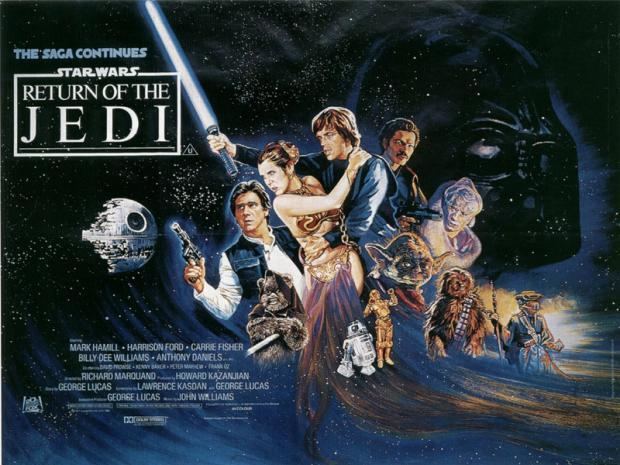
The first installment, Star Wars: The Force Awakens, was released on December 18, 2015 in the U.S., following a special premiere screening in Los Angeles on December 14. The film is directed by J. J. Abrams who cowrote the screenplay with Lawrence Kasdan and Michael Arndt. Harrison Ford, Mark Hamill, Carrie Fisher, and other main cast members from the original trilogy returned to reprise their roles and co-star alongside Daisy Ridley, John Boyega, Adam Driver, and Oscar Isaac.
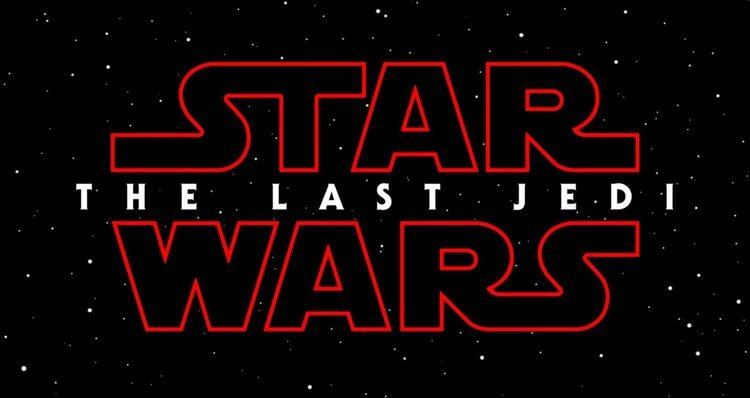
Unlike the previous trilogies, whose films were released approximately three years apart, the sequel films are planned to be released around two years apart. Star Wars: The Last Jedi is set for release on December 15, 2017, with Rian Johnson as screenwriter and director. Johnson is also set to write a story treatment for Episode IX, which is to be directed by Colin Trevorrow and released in 2019.
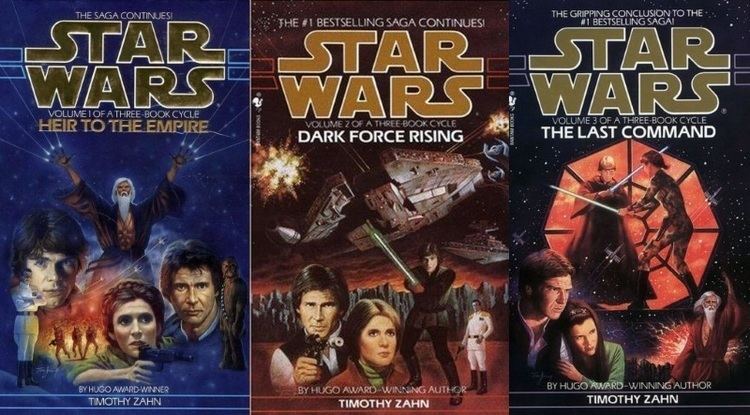
Star wars vii opening
The Force Awakens
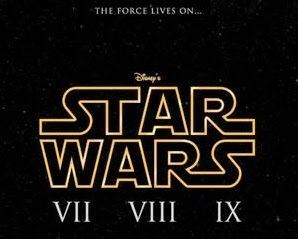
The Force Awakens, the first film in the sequel trilogy, takes place approximately 30 years after the events of Return of the Jedi and includes new characters, as well as characters from the original trilogy, in search of Luke Skywalker with the help of Han Solo, and Princess Leia along with Chewbacca, C-3PO, and R2-D2. The Force Awakens, like the subsequent two films, is based on an original screenplay and not a storyline from the expanded universe.
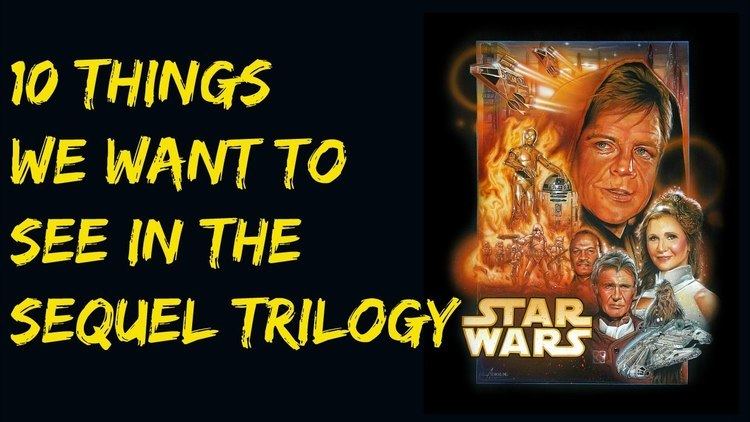
The original trilogy's cast joins newcomers Daisy Ridley, John Boyega, Adam Driver, and Oscar Isaac. It is directed by J. J. Abrams, who co-wrote a revised version of the screenplay along with Lawrence Kasdan, co-writer of the screenplays for The Empire Strikes Back and Return of the Jedi. Original drafts of The Force Awakens script were written by Michael Arndt, but ultimately early character and plot elements in Anrdt's vision came into conflict with the conceptual ideas of director J.J. Abrams and Lucasfilm president Kathleen Kennedy, as well as filming schedules and ultimately Arndt was removed from the project due to creative differences and time constraints, being replaced by Kasdan as the primary co-creative visionary to Abram's plot concepts.
George Lucas was set to provide Abrams with advice as a creative consultant; however, he had no involvement in the film, with his representative saying Lucas "ideally would love not to see any footage until he walks into the theater next December. He has never been able to be surprised by a Star Wars film before and he said he was looking forward to it." The film began pre-production on October 30, 2012. Production began in April 2014; it was released on December 18, 2015. In the US, the film is rated PG-13 "for sci-fi action violence", the second Star Wars film to receive that rating after Revenge of the Sith (the five other films received a PG rating).
The film broke opening weekend box office records in North America with $248 million ($39 million more than previous record holder Jurassic World) and totals of $529 million worldwide, the largest opening ever. The film set another new record by becoming the first movie to break the $1 billion mark in box office sales in just 12 days. It is currently the highest-grossing film of all time in North America and the third highest-grossing film worldwide, unadjusted for inflation.
The Last Jedi
On June 20, 2014, Rian Johnson was announced as writer and director of Episode VIII and story treatment writer of Episode IX. Kathleen Kennedy and Ram Bergman were the producers and J. J. Abrams is the executive producer. Steve Yedlin is the cinematographer. Johnson confirmed in August 2014 that he would direct Episode VIII. It is scheduled for release on December 15, 2017.
In March 2015, Oscar Isaac confirmed he would reprise his The Force Awakens role of Poe Dameron in Episode VIII. In July 2015, it was reported that Benicio del Toro was being considered for a villain; del Toro later confirmed that he had been cast. In September 2015, it was reported that Gugu Mbatha-Raw, Tatiana Maslany, Gina Rodriguez, Olivia Cooke, and Bel Powley were on the shortlist for two separate parts. Jimmy Vee was cast as R2-D2, succeeding Kenny Baker.
Much of the filming for Episode VIII took place at Pinewood Studios near London. In September 2015, some pre-production filming took place on the island of Skellig Michael, Ireland to take advantage of better weather conditions. In a November 2015 interview with Wired, Abrams stated that the film's script was completed. In December 2015, Hamill, Isaac, Christie, and Boyega were confirmed to reprise their roles as Luke Skywalker, Poe Dameron, Captain Phasma, and Finn, respectively. Kennedy announced on December 17, 2015, at the London premiere for The Force Awakens that most of the cast would return for Episode VIII. On January 20, 2016, Lucasfilm and Disney announced that the release of the film would be delayed to December 15, 2017. Principal photography began in February 2016. Additional filming took place in Dubrovnik from March 9 to March 16, 2016, as well as in Ireland. Principal photography wrapped in July 2016. On December 27, 2016, Carrie Fisher died after going into cardiac arrest a few days earlier. Fisher had completed filming her role as General Leia Organa, before her death. On January 23, 2017, the film was given a confirmed release date of December 15, 2017 with the title Star Wars: The Last Jedi.
Episode IX
In August 2015, Colin Trevorrow was announced as the director of Episode IX. Trevorrow, along with Derek Connolly, will be writing the script from Rian Johnson's story treatment. It is scheduled for release in 2019. On February 10, 2016, Disney chief executive officer Bob Iger confirmed that pre-production of Episode IX had begun. Cinematographer John Schwartzman is planning on using 65 mm film. Variety and Reuters reported that Carrie Fisher was slated for a key role in Episode IX. Lucasfilm, Disney and others involved with the film have not revealed how they plan to address Fisher's death and what will become of her character. In January 2017, Lucasfilm stated they would not digitally generate Fisher's performance for the film. Principal photography of Star Wars: Episode IX is set to begin in July 2017.
Initial development
Mark Hamill has stated that Lucas told him in 1976, while filming the first film in Tunisia, that three Star Wars trilogies were planned. Lucas suggested Hamill could have a cameo role in Episode IX, which he imagined filming by 2011. A Time magazine story in March 1978, quoting Lucas, also contained the assertion there would be ten further Star Wars films after The Empire Strikes Back. Gary Kurtz was also aware of proposed story elements for Episode VII to Episode IX before 1980.
In 1980, at the time of the release of The Empire Strikes Back, Lucas said there were seven further Star Wars films he wanted to make. He said he had "twelve-page outlines" for those films. In an interview with Jim Steranko in Prevue magazine published in late 1980, Lucas described how the expansive scope of Star Wars had started with an overlong screenplay:
So, I took the screenplay and divided it into three stories, and rewrote the first one. As I was writing, I came up with some ideas for a film about robots, with no humans in it. When I got to working on the Wookiee, I thought of a film just about Wookiees, nothing else. So, for a time, I had a couple of odd movies with just those characters. Then, I had the other two films, which were essentially split into three parts each, two trilogies. When the smoke cleared, I said, 'This is really great. I'll do another trilogy that takes place after this.' I had three trilogies of nine films, and then another couple of odd films. Essentially, there were twelve films.
He then added that he had:
…eliminated the odd movies, because they really don't have anything to do with the Star Wars saga. ... I'm just going to keep it pure. It's a nine-part saga that has a beginning, a middle and an end. It progresses over a period of about fifty or sixty years with about twenty years between trilogies, each trilogy taking about six or seven years.
In this interview, Lucas also stated that he had "titles and ten-page story outlines for each of" the nine episodes. In an interview with Gary Kurtz in the same magazine, Kurtz said:
[w]hether or not all nine or twelve films actually get made depends on how George feels as time goes along. The series may happen the way he originally planned or may completely change. As the films are made, each of the stories develops. As each is finished, I think the direction of the saga may change a bit.
In an interview with Starlog magazine published in September 1981, Lucas confirmed that he had the nine film series plotted, cautioning:
…but it's a long way from the plot to the script. I've just gone through that with Return of the Jedi, and what seems like a great idea when it's described in three sentences doesn't hold together when you try to make five or six scenes out of it. So plots change a lot when they start getting into script form.
Cancellation and Disney acquisition
From 1997 to mid-2012, Lucas frequently stated that he had no plans to make the sequel trilogy, and said he would not allow others to do so either. He gave various explanations for the apparent abandonment of plans to film the sequel trilogy.
In August 1999, at a press conference in New York City to discuss The Phantom Menace, Lucas described the "nine year commitment" required to make a Star Wars trilogy. In 2002, he said: "Basically what I said as a joke was, 'Maybe when Harrison and Carrie are in their 70s, we'll come back and do another version.' The thing I didn't realize then, and that I do realize now very clearly, is that not only would they be in their 70s, but I would be in my 70s too." In 2007, Lucas described making the films at that age as "an idea that seemed amusing at the time, but doesn't seem realistic now", and suggested that 'off-the-cuff' comments he had made in earlier years had been misconstrued as absolute statements.
At a 1997 "Special Edition" press conference, Lucas said: "Everyone said, 'Well, are you going to do sequels to the first three?' But that was an afterthought; I don't have scripts on those stories. The only notion on that was, wouldn't it be fun to get all the actors to come back when they're 60 or 70 years old and make three more about them as old people." In a 1997 issue of Star Wars Insider, he said: "The whole story has six episodes.... If I ever went beyond that, it would be something that was made up. I really don't have any notion other than, 'Gee, it would be interesting to do Luke Skywalker later on.' It wouldn't be part of the main story, but a sequel to this thing."
In an interview published in the February 1999 issue of Vanity Fair, Lucas said: "When you see it in six parts, you'll understand. It really ends at part six. I never had a story for the sequels, for the later ones." In 2008, after all six films had been released, Lucas said: "The movies were the story of Anakin Skywalker and Luke Skywalker, and when Luke saves the galaxy and redeems his father, that's where that story ends."
In 1999, when asked about the possibility of someone else making Star Wars films, Lucas said, "Probably not, it's my thing." In a 2008 interview in Total Film, Lucas ruled out anybody else making Star Wars films. Asked if he was happy for new Star Wars films to be made after his death, he said: "I've left pretty explicit instructions for there not to be any more features. There will definitely be no Episodes VII–IX. That's because there isn't any story. I mean, I never thought of anything. And now there have been novels about the events after Episode VI, which isn't at all what I would have done with it. The Star Wars story is really the tragedy of Darth Vader. That is the story. Once Vader dies, he doesn't come back to life, the Emperor doesn't get cloned and Luke doesn't get married..."
However, speaking after Disney's 2012 acquisition of Lucasfilm, Lucas (sitting alongside new Lucasfilm president Kathleen Kennedy), said: "I always said I wasn't going to do any more, and that's true, because I'm not going to do any more. But that doesn't mean I'm unwilling to turn it over to Kathy to do more."
Story development
Lucas had story treatments for episodes VII, VIII and IX which he turned over to Disney chairman Bob Iger around the time Lucasfilm was sold to Disney in 2012. However, during an interview with Cinemablend in January 2014 to promote the upcoming release of the Lucasfilm animated movie Strange Magic, Lucas revealed that ultimately, Disney chose not to use the story treatments which he had written and turned over with the acquisition, and that the company chose to create brand new stories for the upcoming movies instead: "The ones that I sold to Disney, they came up to the decision that they didn't really want to do those. So they made up their own. So it's not the ones that I originally wrote [on screen in Star Wars: The Force Awakens]". No information about these has been released; however, during the previous 35 years, Lucas had given many hints about the content of the sequel trilogy, including the following (sometimes contradictory) possibilities:
Interviewed in 2012 after the announcement of the new trilogy, Lucas biographer Dale Pollock said that he had, in the 1980s, read the outlines to 12 Star Wars episodes planned by Lucas, but had been required to sign a confidentiality agreement. Pollock said:
Author Timothy Zahn, whose Star Wars novel series, the Thrawn Trilogy, is set in the Star Wars expanded universe, was also interviewed in 2012. Zahn confirmed the sequel trilogy would not be based on the Thrawn novels, but said he had been briefed years before on Lucas's plans for the sequels (Zahn had discussions with Lucas before the first Thrawn novel was published in 1991). Zahn said:
The original idea as I understood it—and Lucas changes his mind off and on, so it may not be what he’s thinking right now—but it was going to be three generations. You’d have the original trilogy, then go back to Luke’s father and find out what happened to him, and if there was another seventh, eighth, or ninth film, it would be Luke's children.
As announced by Lucasfilm, the new trilogy also meant the end of most of the existing Star Wars expanded universe, so as to give "maximum creative freedom to the filmmakers and also preserve an element of surprise and discovery for the audience." Much of the old content would continue to be available under the "Star Wars: Legends" brand.
